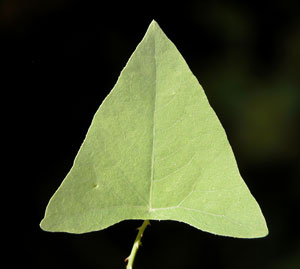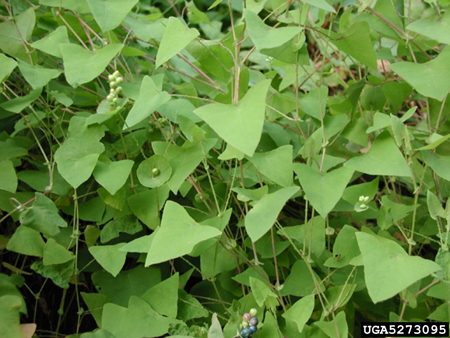Devil's-tail tearthumb - Persicaria perfoliata
Weed Seed - Devil's-tail tearthumb (Persicaria perfoliata)
Devil's-tail tearthumb is an invasive vine that forms tangled mats over other vegetation. It out-competes native plants, impoverishes wildlife habitat, restricts wildlife movement and reduces the aesthetic value of properties and public areas. This plant has a negative impact on industries that produce trees and shrubs.
Where it's found
Devil's-tail tearthumb was previously detected in British Columbia, but did not persist there. Native to eastern Asia, it is now highly invasive in the north-eastern United States. Habitats include riverbanks and a wide variety of disturbed areas, including roadsides, hedges, fields, pastures and forest edges, early forests, plantations, gardens and parks.
What it looks like
Devil's-tail tearthumb is a sprawling annual or perennial vine with thin, prickly stems. It has small white or pink flowers that give rise to metallic blue berries. Also distinctive are its triangular leaves and cup-shaped ocreae (leafy sheaths) surrounding its flowers and nodes. Backward-curved barbs are present on stems and leaves.
How it spreads
Devil's-tail tearthumb reproduces by seed. It is known for its remarkably rapid vegetative growth. People may unintentionally transport devil's-tail tearthumb with nursery stock. The seeds may be transported in root balls or the vines may be wound around stems. People may also transport the seeds in association with ornamental seed, hay, mulch, vehicles, equipment, clothing and baggage. Natural means of dispersal include water, ants, birds, small animals and deer.
Legislation
Devil's-tail tearthumb is regulated as a pest in Canada under the Plant Protection Act. It is also listed as a prohibited noxious weed on the Weed Seeds Order, 2016 under the Seeds Act. Importation and domestic movement of regulated plants and their propagative parts is prohibited.
What you can do about it
- Leave natural items in their natural habitat.
- Use clean, high-quality seed that is certified if possible.
- Ensure machinery, vehicles and tools are free of soil and plants before moving them from one area to another.
- Contact your local Canadian Food Inspection Agency (CFIA) office if you suspect you have found this invasive plant. The CFIA will follow up and determine if further action is needed.
Learn more about invasive species.

Attribution: Todd Mervosh, Connecticut Agricultural Experiment Station

Attribution: Todd Mervosh, Connecticut Agricultural Experiment Station

Attribution: L.J. Mehrhoff, University of Connecticut, Invasive.org (Bugwood.ca)
- Date modified: